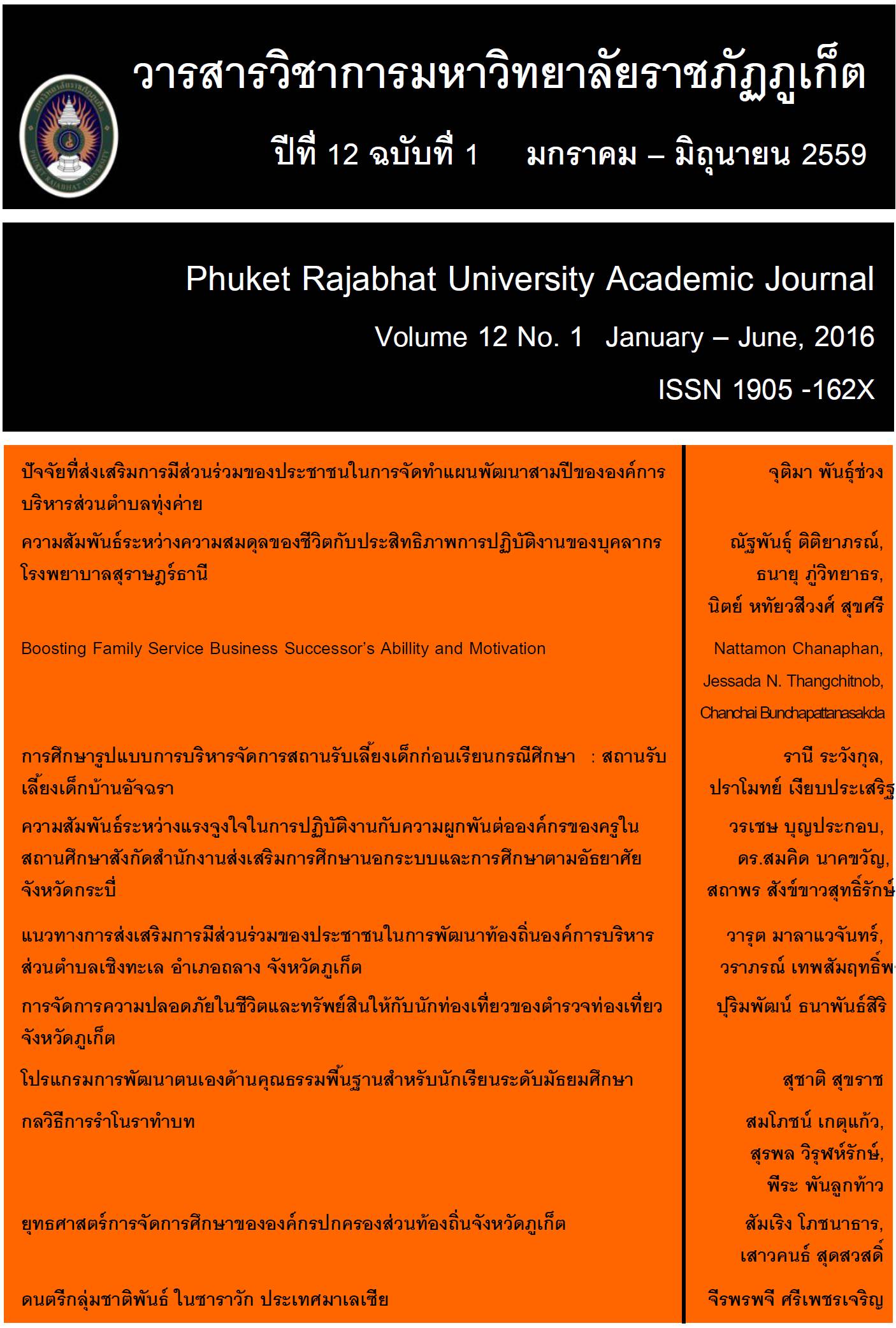การเสริมความสามารถและแรงจูงใจของทายาทธุรกิจครอบครัวด้านการบริการ
Main Article Content
บทคัดย่อ
การเสื่อมสลายในรุ่นที่สามของธุรกิจครอบครัวอาจเกิดขึ้นจากการลดลงของแรงจูงใจในการประกอบการของทายาทธุรกิจหรือเกิดขึ้นจากการเตรียมการเพื่อการสืบทอดธุรกิจที่ไม่สมบูรณ์ของผู้ดำรงตำแหน่งก่อนด้วยความตระหนักในความสำคัญต่อระบบเศรษฐกิจของธุรกิจครอบครัวการวิจัยนี้จึงศึกษาในเชิงคุณภาพว่าการสืบทอดธุรกิจครอบครัวประสบความสำเร็จเพียงใดและปัจจัยใดช่วยเพิ่มความสามารถและแรงจูงใจให้แก่ทายาทธุรกิจและหรือช่วยลดอุปสรรคในการสืบทอดธุรกิจ จากทายาทธุรกิจของสิบธุรกิจครอบครัวด้านบริการที่จดทะเบียนในตลาดหลักทรัพย์แห่งประเทศไทย แม้ว่าผลวิจัยจะให้การสนับสนุนบางส่วนแต่ไม่สามารถสรุปได้ว่าการสืบทอดธุรกิจครอบครัวประสบความสำเร็จในทุกด้านทั้งนี้ปัจจัยการมีทีมที่มีความสามารถร่วมกับปัจจัยอื่นๆอีกห้าปัจจัยเป็นปัจจัยที่ทายาทธุรกิจระบุว่าช่วยเพิ่มความสามารถและแรงจูงใจให้แก่ทายาทธุรกิจและหรือช่วยลดอุปสรรคในการสืบทอดธุรกิจผู้ส่งมอบธุรกิจครอบครัว อาจพิจารณาจัดการปัจจัยเหล่านี้ให้มีความเหมาะสมสอดคล้องกับบริบทของกระบวนการสืบทอดธุรกิจของตน
Article Details
เนื้อหาและข้อมูลในบทความที่ลงตีพิมพ์ในวารสารวิชาการมหาวิทยาลัยราชภัฏภูเก็ต ถือเป็นข้อคิดเห็นและความรับผิดชอบของผู้เขียนบทความโดยตรง ซึ่งกองบรรณาธิการวารสารฯ ไม่จำเป็นต้องเห็นด้วยหรือร่วมรับผิดชอบใด ๆ
บทความ ข้อมูล เนื้อหา รูปภาพ ฯลฯ ที่ได้รับการตีพิมพ์ในวารสารวิชาการมหาวิทยาลัยราชภัฏภูเก็ต ถือเป็นลิขสิทธิ์ของวารสารวิชาการมหาวิทยาลัยราชภัฏภูเก็ต หากบุคคลหรือหน่วยงานใดต้องการนำทั้งหมดหรือส่วนหนึ่งส่วนใดไปเผยแพร่ต่อหรือเพื่อกระทำการใด ๆ จะต้องได้รับอนุญาตเป็นลายลักษณ์อักษรจากวารสารวิชาการมหาวิทยาลัยราชภัฏภูเก็ตก่อนเท่านั้น
เอกสารอ้างอิง
Carraher, S. M. (2005). An examination of entrepreneurial orientation : A validation study in 68 countries in Africa, Asia, Europe, and North America. International Journal of Family Business. 2(1) : 95-100.
Carraher, S. M., & Carraher, S. C. (2006). Human resource issues among SME’s in Eastern Europe : A 30 month study in Belarus, Poland, and Ukraine. International Journal of Entrepreneurship. 10 : 97-108.
De Massis, A., Chua, J. H., & Chrisman, J. J. (2008). Factors preventing intra-family succession. Family Business Review. 21(2) : 183 - 199.
Dumas, C., Dupuis, J. P., Richer, F., & St.-Cyr, L. (1995). Factors that influence the next generation’s decision to take over the family farm. Family Business Review. 8(2) : 99–120.
European Family Businesses. (2012). Family Business Statistics. Bruxelles : European Family Businesses.
Fischetti, M. (1997). The Family Business Succession Handbook. Philadelphia Family Business Publishing.
Fox, M., Nilakant, V., & Hamilton, R. T. (1996). Managing succession in family-owned Businesses. International Small Business Journal. 15(1) : 15–25.
Greenberg, J., & Baron, R. A. (1997). Behavior in organization (6th ed.). New Jersey : Prentice Hall.
Goldberg, S. D. (1996). Research note : Effective successors in family-owned businesses : Significant elements. Family Business Review. 9(2) : 185-197.
Handler, W. C. (1994). Succession in family business : A review of the research. Family Business Review. 7(2) : 133-157.
Harvey, M., & Evans, R. E. (1995). Life after succession in the family business : Is it really the end of problems? Family Business Review. 8(1) : 3-16.
Lam, L. F. (2015). Two generations’ perception of a successful business succession in small and medium-sized family business. [On-line]. Available : https://csumb.edu/sites/default/files/images/st-block-31-14281728170524009-raw-twogenerationperception of success2014.pdf. [2015, June 6].
Landes, D. S. (1965). Technological change and development in Western Europe, 1750-1914. In Habakkuk, H. J. & Postan, M. (eds.). The Cambridge Economic History of Europe (6th ed.). Cambridge : Cambridge University Press.
Lank, A. (1994). Generalizations and observations about family businesses in eastern Europe. Chicago : Loyola Press.
Matthews, C. H., Moore, T. W., & Fialko, A. S. (1999). Succession in the family firm : A cognitive categorization perspective. Family Business Review. 12(2) : 159-169.
Morris, M. H., Williams, R. W., Allen, J. A., & Avila, R. A. (1997). Correlates of success in family business transitions. Journal of Business Venturing. 12(5) : 385-401.
Neubauer, H. (2003). The dynamics of succession in family businesses in western european countries. Family Business Review. 16(4) : 269–281.
Neubauer, F., & Lank, A. G. (1998). The family business : Its governance for sustainability. London : Macmillan.
Pereira, M. F., Lisoni, J., & Serra, F. (2007). Family business : How family and ownership shapes business professionalization. Paper presented at the 2007 Business Association for Latin American Studies Annual Conference, San Jose.
Santiago, A. L. (2000). Succession experience in Philippine family businesses. Family Business Review. 8(1) : 15-40.
Sharma, P. (2004). An overview of family business studies : Current status and directions for the future. Family Business Review. 17(1) : 1-36.
Sharma, P., Chrisman, J. J., Pablo, A. L., & Chua, J. H. (2001). Determinants of initial satisfaction with the succession process in family firm : A conceptual model. Entrepreneurship Theory and Practice. 25(3) : 17-36.
Stavrou, E. (1995). The next generation’s Dilemma : To join or not to join the family business. Paper presented at the Family Firm Institute Conference, St. Louis.
Stavrou, E. (1999). Succession in family businesses : Exploring the effects of demographic factors on offspring intentions to join and take over the business. Journal of Small Business Management. 37(3) : 43–62.
Venter, E., & Boshoff, C. (2006). The influence of family-related factors on the succession process in small and medium-sized family businesses. South African Journal of Economic and Management Sciences. 9(1) : 17-32.
Venter, E., & Boshoff, C. (2007). The influence of organisaional-related factors on the succession in small and medium-sized family business. Management Dynamics. 16(1) : 42-55.
Venter, E., Boshoff, C., & Maas, G. (2005). The influence of successor-related factors on the succession in small and medium-sized family business. Family Business Review. 18(4) : 283-303.
Ward, J. L. (1988). The special role of strategic planning for family businesses. Family Business Review. 1(2) : 105-117.
Ward, J. L. (2005). Unconventional wisdom : Counterintuitive insights in family business success. Chichester : John Wiley & Sons.


